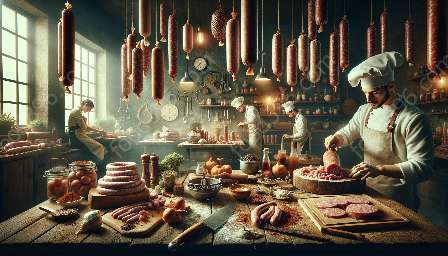Explore the art of sausage making through smoking and drying methods to preserve and process food, delving into the intricacies of this culinary craft. From ancient techniques to modern innovations, discover the fascinating world of sausage production.
Introduction to Sausage Making
Sausage making is an ancient culinary tradition that has evolved over time. It involves the combination of ground meat, fat, seasoning, and other ingredients, encased in a casing, which can be natural or artificial. The process of making sausages includes various stages such as grinding, mixing, stuffing, and curing, ultimately leading to the final product.
Types of Sausages
There are numerous types of sausages across the globe, each characterized by its unique flavor profile and preparation methods. Some popular varieties include Italian sausage, bratwurst, chorizo, and kielbasa. The choice of meat, seasonings, and cooking techniques contribute to the diverse range of sausages available.
Smoking Methods
One of the key techniques in sausage making is smoking, which imparts a distinct flavor and aroma to the sausages. There are various smoking methods, including hot smoking and cold smoking, each offering a different outcome. Hot smoking is done at higher temperatures and fully cooks the sausages, while cold smoking is done at lower temperatures, primarily for flavor enhancement without fully cooking the sausages.
Wood selection plays a crucial role in smoking sausages, as different woods contribute unique flavors to the meat. Common woods used for smoking include hickory, applewood, mesquite, and cherry. The choice of wood influences the final taste of the sausages, allowing for endless experimentation and creativity.
Drying Methods
In addition to smoking, drying is another method used in sausage making to preserve and enhance the flavor and texture of the sausages. Drying can be achieved through various means, such as air-drying, fermentation, and aging. These methods help remove moisture from the sausages, resulting in a concentrated and rich flavor.
Air-drying involves hanging the sausages in a well-ventilated environment for an extended period, allowing them to gradually lose moisture while developing complex flavors. Fermentation is a controlled process where beneficial bacteria break down sugars and proteins in the sausages, contributing to the development of tangy and savory notes. Aging, on the other hand, involves storing sausages in controlled conditions for an extended duration, resulting in a more intense and nuanced flavor profile.
Food Preservation & Processing
Smoking and drying methods for sausages are integral to the broader concept of food preservation and processing. These techniques have been employed for centuries to extend the shelf life of meats and create unique culinary experiences.
Historical Significance
The practice of smoking and drying meats, including sausages, dates back to ancient civilizations. Before the advent of refrigeration, preserving meats was essential for survival, particularly in regions with harsh climates. Smoking and drying offered a means of preventing spoilage and ensuring a stable food supply throughout the year.
Modern Applications
Today, smoking and drying methods continue to play a vital role in the food industry, enabling the production of flavorful and shelf-stable products. Sausages that are smoked and dried have gained popularity not only for their extended shelf life but also for their unique taste and texture. These techniques are also utilized in the production of other processed meats, such as jerky and salami, showcasing their versatility and adaptability in the modern culinary landscape.
Health and Safety Considerations
When utilizing smoking and drying methods for sausages, it is essential to adhere to proper food safety practices to prevent the growth of harmful bacteria. Controlling temperature, humidity, and air circulation is critical in ensuring the safety and quality of the final products. Additionally, choosing high-quality ingredients and maintaining strict hygiene standards are imperative for producing safe and delicious sausages.
Conclusion
Exploring the smoking and drying methods for sausages provides a fascinating insight into the art of sausage making and the broader context of food preservation and processing. From the historical significance to modern applications, these techniques offer a rich tapestry of flavors and traditions that continue to captivate culinary enthusiasts worldwide.

